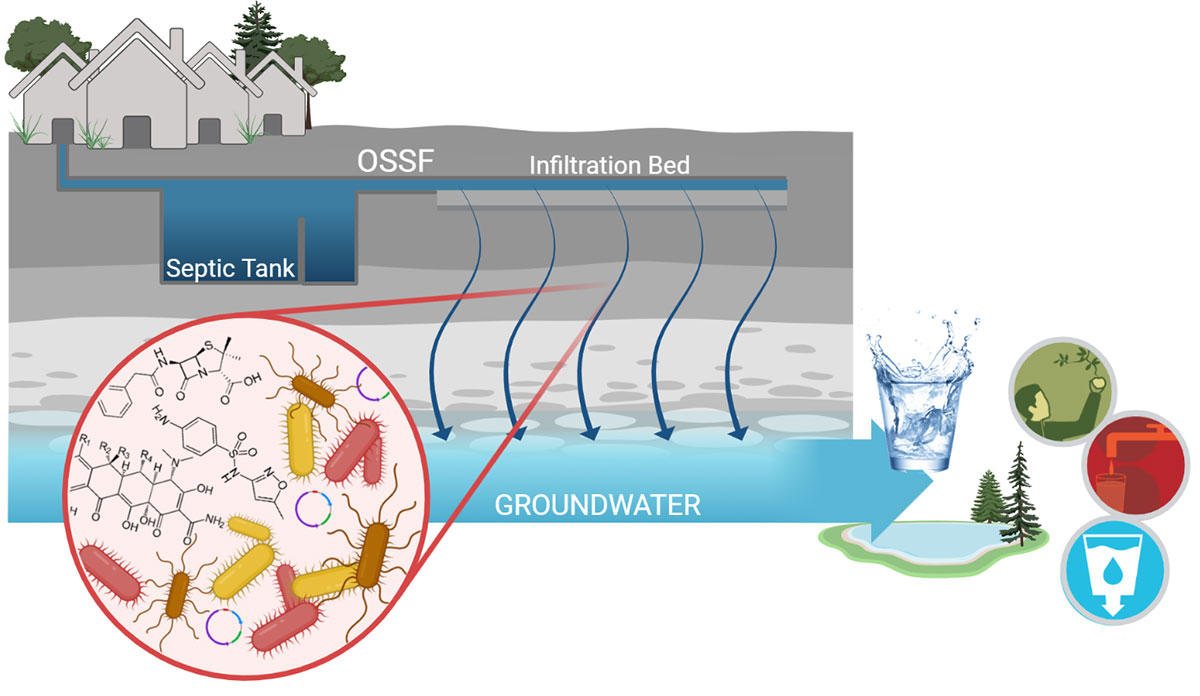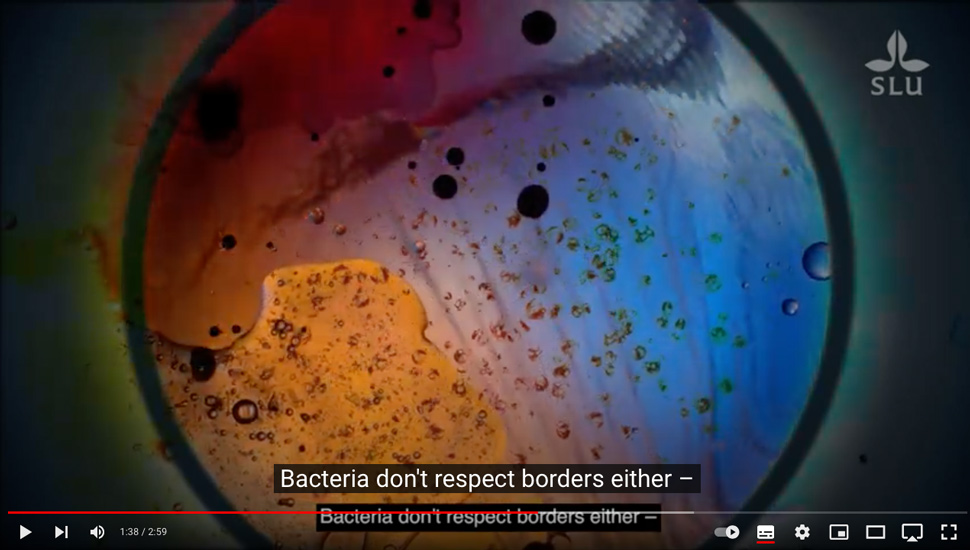
Example of a larger production facility, with chickens housed on multiple floors in several buildings. This particular farm in Uganda had about 17,000 chickens on seven storeys in several buildings.
Photo: Olivia Graaf Bjöersdorff.
The consumption of antibiotics in the world is increasing, and bacteria are becoming ever more resistant to this vital medical tool. Here we present two stories that exemplify how SLU contributes to this fight against antimicrobial resistance.
The development of resistance is natural and normal due to the adaptability of bacteria. But the consequences can be serious. Antimicrobial resistance (AMR) has been called a silent pandemic because it spreads slowly in the shadow of other infections and crises around the world. Over 30 years have passed since a new class of antibiotics has been discovered. At the same time, the consumption of antibiotics in the world is increasing, and bacteria are becoming ever more resistant to this vital line of defense.
![]()
What would a future without effective antibiotics be like?
Imagine no longer being able to treat common infections such as pneumonia. Having to slaughter a cow with a simple udder inflammation because there is no effective treatment. Or a pig farmer going bankrupt if his stock develop swine dysentery. All the infections that are treatable today suddenly become life threatening.
According to the World Health Organization (WHO), antibiotic resistance is one of the biggest threats to global health and food security, and the key message is that we need to work together to reduce the use of antibiotics and, at the same time, develop new drugs.
Susanna Sternberg Lewerin, Professor at SLU’s Department of Biomedical Science and Veterinary Public Health explains, ‘The scope and complexity of the problem demand that scientists from different fields work together, so our decision-makers can act globally and forcefully.’ 
Bacteria have become increasingly resistant to antibiotics, which is a major concern as resistant bacteria can spread in many different ways, including directly between humans and animals or indirectly through food and the environment. The One Health approach is essential due to the strong links between people, animals and the environment.
Susanna continues, ‘We researchers at SLU work with disease prevention measures and responsible use of antibiotics in livestock production as well as for pets – with aspects such as food safety and how our environment is affected by this resistance problem.’
In this article, we touch on two projects, which aim to reduce the use of antibiotics and contribute to the problem of resistance. One with a focus on wastewater in Sweden. But we begin in East Africa and the antibiotic situation of poultry producers.
![]()
We travel to Kenya and Uganda to get an idea of poultry production practices in these countries, where there are both small-scale producers and bigger commercial farms. Many farmers have a handful of free-range chickens for meat and/or egg production, which they either sell or consume in their own households. The commercial farms usually keep their birds indoors.

Example of a larger production facility, with chickens housed on multiple floors in several buildings. This particular farm in Uganda had about 17,000 chickens on seven storeys in several buildings.
Photo: Olivia Graaf Bjöersdorff.

It is common in Uganda for traders to buy live chickens from the farms and sell them at markets. Here, a number of chickens in a cage are being transported by moped, or bodaboda, to a market for sale.
Foto: Olivia Graaf Bjöersdorff.

An example of small-scale poultry production. A farmer is being interviewed about the daily care of his chickens. About 150 chickens lived in this separate part of one of the farm buildings. Pius Okello, a Ugandan veterinarian, is also pictured.
Foto: Olivia Graaf Bjöersdorff.
Poor roads make the farms inaccessible, and it is difficult for veterinarians to get there. Usually they make their visits by motorcycle. Just the cost of petrol to get a veterinarian to the farm can be significant, which tends to make the farmers unwilling to call in the experts.
‘When the animals get sick, the farmers consult the staff at the local farm supply shops, where they buy animal feed and medicine that the shop owners recommend. The staff may not have any knowledge about animal health, meaning they may give poor advice. These people are shop owners whose primary aim is to sell their products.’

It is common that farmers do not contact a veterinarian, for a number of reasons. Instead, they turn to farm supply shops when their hens become ill, whose staff often lack knowledge about animal health. This photo shows an ‘Agrovet Shop’ in Kenya. Photo: Florence Mutua
Farmers who can afford to consult a veterinarian often wait until they have tried to treat the animal themselves, without success. By the time a veterinarian is contacted, it is often too late to cure the animal.
‘Many farmers do not know how to contact a veterinarian either. We want to help the farmers gain access to professional advice and veterinarians to get in touch with the producers. Countries like Uganda and Kenya also have a general lack of advice on how to keep animals healthy. In contrast to Sweden, where we have a long tradition of preventing illness, and where we work on the premise that healthy animals don’t need antibiotics, but sick animals do,’ Susanna says.
![]()
SLU is contributing to a project that explores how information technology can be employed to reduce the use of antibiotics in East Africa.
A digital portal is being built to spread knowledge about common poultry diseases and their prevention, as well as information on the correct use of antibiotics.
The farmers will also be able to use the portal to register their use of pharmaceuticals and details about animal diseases. They will also have access to information on how to contact a veterinarian and where to find the nearest shop that supplies medicines. These shops must also register sales of medicines (reporting is already mandatory). Everyone who registers information will be able to see how their data compares with general trends in all the data entered.
‘We will also be trying out video calls as a cheaper way for farmers to contact veterinarians. Even if it isn’t possible to examine the animal as thoroughly using this method, we believe it will improve the use of medicines and reduce the risk of antibiotic resistance,’ Susanna concludes.

Increasing knowledge in low- and middle-income countries like Uganda and Kenya is crucial to combating antibiotic resistance. The withdrawal period is the period in which products such as eggs, milk and meat from a treated animal might contain pharmaceutical residues. Many farmers do not understand the consequences of consuming meat and eggs during this period and believe that cooking is enough to eliminate the problem.
Photo: Jenny Svennås-Gillner

In 1986, Sweden, as the first country in the world banned all use of antibiotics as growth promoters in animal production. Today, Sweden has the 3rd lowest sales of antimicrobial agents for food producing animals in Europe, as a result of decades of inter-sectorial collaboration and work on disease prevention and animal health.
The ‘Swedish model’ is based on keeping farmed animals healthy and well and only using antibiotics when they are really needed. You can read more about this model in the report; ‘The Swedish experience’.
Photo: Jenny Svennås-Gillner
In Sweden, Associate Professor Foon Yin Lai researches the wastewater purification. Remnants of antimicrobial agents can spread to the groundwater, such as antimicrobial chemicals (e.g. antibiotics) and antibiotic resistance genes (ARGs). Foon Yin is studying how these agents can be eliminated and how to prevent the spread of antimicrobial resistance (AMR).
‘My research focuses on reducing the contaminants before they reach the groundwater so they do not spread further to nature or to humans,’ she says.

SLU Associate Professor Foon Yin Lai and her research group use advanced analytical instrumentation, co-called LC-MS/MS, in the laboratory at Ultuna Campus to measure which and how much AMR chemical contaminants present in the wastewater and groundwater collected from the field work. Photo: Ulrika Jansson Klintberg
Many of the major sewage treatment plants help in removing some antimicrobial agents. But for 13% of Swedish households, sewage treatment occurs at smaller plants, so-called on-site sewage facility (OSSF), closer to where it is used and discharged (via sewers).

Purification systems: Household wastewater flows into septic tanks, where organic impurities sink to the bottom. But some impurities, such as antimicrobial chemicals (e.g. antibiotics) and antibiotic resistance genes (ARG), can still be carried to the infiltration bed and require more purification variables to remove. Without these, chemicals and ARG can spread to the groundwater and from there into nature and to humans.
Foon Yin has installed a device that has taken water samples over the course of a year from an OSSF in a remote community in Småland in southern Sweden.
‘The municipality has helped us take samples outside the area to see if there are traces of antibiotic resistance, both before the water is used by the households and afterwards. One family is offering us access to their ground water source, so we can see how effectively the treatment plant is eliminating the problems.’
Foon Yin is looking forward to seeing the results of the analyses: how much are the antimicrobial chemicals and ARGs spreading? And how much does adding more treatment variables to the infiltration beds help to keep ARGs from spreading to the groundwater?
‘A healthy environment is important to me, and I really hope that these purification variables work. That would help on-site sewage treatment plants to stop the spread of ARGs and prevent AMR.’

![]()

The One Health approach is essential due to the strong links between people, animals and the environment. In this film we explains the One Health approach.
SLU Future One Health is a platform that supports and promotes transdisciplinary research addressing such issues as antimicrobial resistance. You can read more about what we do here.
More information about these two projects:
![]()
Story:
Eva-Stina Lindell, e-mail, Communications Officer, SLU Future One Health
Press & research contacts:
Susanna Sternberg Lewerin, Professor at the Department of Biomedical Science and Veterinary Public Health at SLU. E-mail.
Foon Yin Lai, Associate Senior Lecturer at the Department of Aquatic Sciences and Assessment at SLU. E-mail.
Production:
SLU Division of communication, e-mail
The content is free to share in its original form if the source/url is cited.
![]()
An eye for science. We see the world through our own eyes. Sometimes we need a microscope to see the bigger picture, other times patterns are clearer at a distance. Beauty can catch your eye from the bottom of a petri dish, during a walk in the woods, or in a new data series. SLU brings together people who have different perspectives, but they all have one and the same goal: to create the best conditions for a sustainable, thriving and better world.
